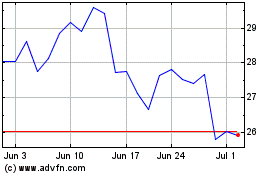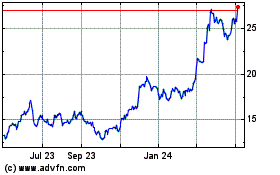Asian Sky Still Bright, Plane Makers Say
February 16 2016 - 9:22AM
Dow Jones News
By Gaurav Raghuvanshi
SINGAPORE--Aircraft makers such as Boeing Co., Airbus Group SE
and Embraer SA say they aren't worried that the economic slowdown
in Asia, especially China, will hurt sales in the world's
fastest-growing aviation market.
Rather, some are still trying to keep up with demand.
"My biggest worry is not being able to build all the aircraft
that we've already sold," John Leahy, chief operating officer of
Airbus, said at a news conference at the Singapore Airshow on
Tuesday.
Financial markets have been spooked by China's slowing growth.
Last year, Beijing reported, the world's second-largest economy
grew at its slowest pace in 25 years, 6.9%--and many economists say
they believe the true figure is closer to 6%. But China is still
expanding faster than any other major economy. And China, India and
Southeast Asia remain the fastest-growing aviation markets in the
world.
Airbus predicts that over the next 20 years, the Asia Pacific
region will take delivery of 12,800 new aircraft, valued at US$2
trillion. That would constitute about 40% of its projected total
global demand of 32,600.
The Toulouse, France-based company expects the number of
passengers in Asia to keep growing 5.6% a year over the next 20
years. It remains bullish about China, where it expects to deliver
800 planes between now and 2020, and where Mr. Leahy said he
expects passenger growth to stay at 10% over the next few
years.
Arch rival Boeing predicts Asia will take delivery of 14,330
planes over the next 20 years, 38% of its projected global total.
"The Asia story will only get better," said Dinesh Keskar, senior
vice president of sales in Southeast Asia and India at Boeing.
Embraer, which builds smaller planes, predicts that over the 20
years the Asia-Pacific region will take delivery of 1,570 new jets
with seating for between 70 and 130 passengers.
"We are enjoying momentum in China," said John Slattery, chief
commercial officer at Embraer Commercial Aviation. Despite the
slight slowdown in China's gross domestic product, "the aviation
market continues to grow at double digits."
Asia Pacific commercial-aviation sales will grow 9.2% a year in
nominal U.S. dollar terms between now and 2020, outpacing the
global 7.5% rate, Rajiv Biswas, chief economist in Asia Pacific at
IHS Global, forecast in a recent report.
Sliding crude-oil prices have helped airlines cut costs. Fuel
accounts for nearly a third of the total expenses of airlines in
Asia, Mr. Biswas said.
No deliveries have been canceled or deferred by Asian customers,
Boeing and Embraer executives said in responses to queries from
reporters. Mr. Leahy said no customers are negotiating to reduce
orders "outside the normal course of business." Airbus reported
later Tuesday that Garuda Indonesia canceled an order for seven
A330 jets.
Airbus officials couldn't immediately be reached for comment.
Arif Wibowo, Garuda's chief executive, said the carrier is
evaluating offers from both Boeing and Airbus for the newest
variants of their planes and may order up to 30 widebody jets this
year. The company may swap some orders for older variants for the
latest ones, he said, before Airbus announced the cancellation of
the order for seven older models.
No big orders were announced on the first day of the Singapore
Airshow, which runs through the end of this week.
Airbus announced in October that it will increase production of
its best-selling A320 model by 2019 to 60 planes a month from the
current 42 A320s; it had previously disclosed plans to raise
monthly output to 50 planes next years. Boeing plans to lift
production of its rival 737 jetliner to 52 a month in 2018.
Asia is home to some of Airbus's biggest customers: India's
InterGlobe Aviation Ltd., which operates IndiGo, Malaysia's AirAsia
Bhd. and Indonesia's Lion Air Group have placed orders for hundreds
of planes in recent years.
Several analysts have said that Asian carriers may have been
getting ahead of themselves: Passenger growth for carriers in
Southeast Asia, for instance, lags behind fleet growth. AirAsia was
forced to defer some of its aircraft deliveries in 2014.
Write to Gaurav Raghuvanshi at gaurav.raghuvanshi@wsj.com
(END) Dow Jones Newswires
February 16, 2016 09:07 ET (14:07 GMT)
Copyright (c) 2016 Dow Jones & Company, Inc.
Embraer (NYSE:ERJ)
Historical Stock Chart
From Mar 2024 to Apr 2024

Embraer (NYSE:ERJ)
Historical Stock Chart
From Apr 2023 to Apr 2024
